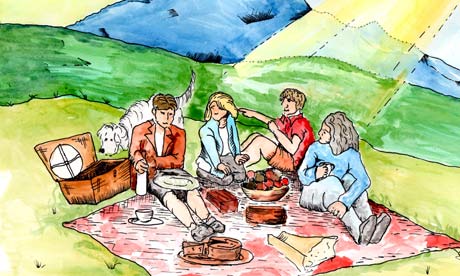
Seventy years ago this summer, Julian, Dick and Anne went to stay with their cousin Georgina at Kirrin Cottage. Across the following two decades, the Famous Five put away their fair share of villains and ne'er-do-wells, as well as a few hard-boiled eggs, jars of potted meat and cucumber sandwiches. I grew up on a diet of Famous Five. The food connection, however, passed me by until my five-year-old son observed: "These children eat a lot, Dad." He's right; the books evoke thoughts of splendid picnics under sunny blue skies, washed down with ginger beer and home-made lemonade.
Blyton wrote 21 Famous Five books, the first, Five on a Treasure Island, was published in 1942. As Dr Joan Ransley, honorary lecturer in human nutrition at the University of Leeds, notes: "The food eaten in the books anchors the Famous Five to a definite period in dietary history. During and immediately after the second world war British children ate well but austerely and Blyton is true to this." In other words, they ate healthily but not heartily. Well over half of the books were written during food rationing. Perhaps Blyton is consciously enticing her readers with elaborate descriptions of foods way beyond the ration book allowance.
In that first book, a simple spread of cold ham, salad, bacon and eggs, plums and a ginger cake fuelled the discovery of gold ingots on Kirrin Island. But over the years, as the five go off in a caravan, or camping on Billycock Hill, the author has discovered the importance of food in recounting a good yarn: "A large ham sat on the table, and there were crusty loaves of new bread. Crisp lettuces, dewy and cool, and red radishes were side by side in a big glass dish, great slabs of butter and jugs of creamy milk" – simple descriptive skills which make the food hugely appealing. Menu writers take note.
Staples are found throughout: ham, bacon, eggs, the ubiquitous ginger beer and lemonade, together with loaves of crusty bread and cakes and buns. But luxuries – chocolate for example – don't find their way onto the menu until the postwar years. Blyton doesn't goad us with unobtainable "exotics" as Elizabeth David did in the 1950s, rather she describes familiar foodstuffs, albeit available to her readers in much reduced quantities through the rationing system.
The five eat a balanced diet. Despite an abundance of humbugs, toffees and ginger pop, when grouped into the five main food categories (fruit and vegetable; meat and fish; dairy; starchy foods; high fat/sugar foods), no one group outweighs another. This comes naturally to the children rather than by diktat. Sweets are eaten sparingly; hunks of crusty bread are accompanied by handfuls of radishes or fresh fruit.
The children manage a structured approach to eating. Breakfast, lunch, dinner and supper all mark out the day. Even while cavorting across the moors in search of spook trains, the five will stop and sit down so that a meal becomes an enjoyable social interaction. Mealtimes provide an opportunity for the children to share thoughts and to take in all that is happening to them. In today's climate of economic uncertainty, we could do worse than adopt Blyton's approach to eating and take the time to enjoy simple foods.

